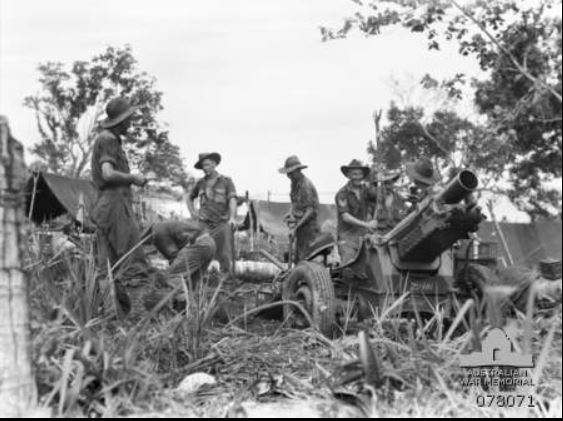2/3rd Australian Field Regiment
From Our Contribution
 A short 25-pounder near Danmap, New Guinea Jan 1945 - AWM image 098071 | |
 25 Pounder of 2/3rd Field Regiment - AWM image P10262.014 | |
Contents
[hide]Brief History
Formed on 1 Nov 1939 at Wayville, South Australia with soldiers from all six states and the Northern Territory. South Australian enlistees formed the 5th Battery, while men from other states the 6th Battery. Following basic training at Woodside the Regiment moved to Ingleburn in New South Wales for further training in December. In May 1940 the regiment was sent to Egypt aboard HMT Queen Mary. However, mid voyage the Germans invaded France and as a result the ship's destination changed to England via Cape Town. On arrival they were sent to Tidworth, before moving later to Colchester where they were placed on Garrison duties to defend against any German invasion.
Once the threat of invasion was over, they moved to North Africa in November 1940 aboard the Empress of Canada. Allocated to the 6th Division they saw action against the Italians at Tobruk, Benghazi and Marsa Brega before being withdrawn. In early April 1941 they were sent to Greece to support Australian and New Zealand infantry seeking to oppose the German invasion. On 6 April they began the move towards the Yugoslav border and three days later they were the first Australian artillery unit to engage German forces in WW 2. Initial success was followed by them being pushed back to Servia through driving snow and frequent attack from fighter bombers in addition to German infantry. This was followed by a series of disastrous withdrawals during which they lost all of their equipment. On 27 April the regiment was evacuated to Crete on board HMS Ajax.
Now without guns, they were organised as part of an ad hoc infantry unit before being re-equipped with captured Italian and French artillery pieces and given a coastal defence role at Georgopolis. With the arrival of German paratroopers on 20 May the regiment was move to Maleme airfield and Retimo to support the 19th Infantry Brigade. Later in the month they were forced to withdraw towards Sphakia, and destroyed most of their equipment, saving two 75mm guns which they man packed over mountainous terrain to act as a rearguard for the evacuating troops at Suda. Some of the regiment were able to be evacuated, while others sought to evade capture for a time. During the Greece and Crete campaign the regiment lost 27 dead and 47 wounded in addition to the 129 captured on Crete and 1 in Greece.
Reformed in Palestine, it now included the 53rd battery, with each battery having four guns. In February 1942 as part of the 6th Division, it was returned to Australia. Following a brief time in Adelaide it was sent to Townsville by rail in May before moving north to Cairns. In June they were located on the Atherton Tablelands where it re-organised for jungle warfare, which included reducing personnel from 736 to 688. Re-equipped with some short 25 pounders, it spent late 1943 and early 1944 based around Wondecla.
It was December 1944 before they saw action again, as part of the 6th Division's campaign in the Aitape - Wewak area. Here they also added 4.2 inch mortars to their armoury to better provide close support to infantry patrols. Two 155 mm guns were also added. The regiment saw action to the end of the war, firing the last fire mission in the New Guinea campaign, having to fire 1,000 rounds on targets eight hours after the Japanese surrender to deal with a Japanese battery that was continuing to hold out. Returned to Australia, the regiment was disbanded at Puckapunyal on 18 Jan 1946. Total losses during the war was 46 deaths, 49 wounded and 130 captured from the 1,887 men who had served in the unit.
Regiment Personnel
- Raymond Eric Gerard Bennett 21 Nov 1939 - 9 Feb 1943
- John Davidson 21 Nov 1939 - 9 Feb 1943
- John Hartley Craddon 6 Sep 1941 - 6 Jun 1944
- Thomas John Walsh 27 Oct 1941 - 16 Jun 1945
- Arthur Samuel William Alldridge 22 Nov 1941 - 123 Mar 1942
- Leo Gibbs 2 Aug 1944 - 12 Oct 1945
- Alexander William Turner MID 1 - 25 Dec 1945
Battle Honours
- North African Campaign
- Battle of Greece
- Battel of Crete
- Aitape-Wewak Campaign
Individual Honours
- 1 x Distinguished Service Order
- 3 x Order of the British Empire
- 4 x Military Cross
- 2 x Distinguished Conduct Medals
- 1 x Military Medal
- 43 x Mentioned in Despatches
Notes